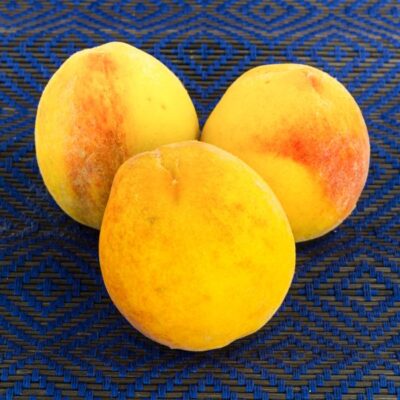Garden Plant: Muir Peach Tree
Product Description: Muir Peach Tree

High Quality Heirloom, Disease-Resistant Muir Peach
- Late Mid-Season
- Delicious Heirloom Variety
- Yellow Freestone Peach
- Large, Sweet, Red Blushed Fruit
- Perfect for Fresh Eating, Drying and Canning
- #1 Canning Peach at Turn of 20th Century
- Vigorous Tree with Prolific Fruit Production
- Disease Resistant to Peach Leaf Curl
Deciding which Peach to plant can be a tough choice. After all, there are so many wonderful varieties out there to choose from.
Perhaps this will help. Here are a few paraphrased quotes about the heirloom Muir Peach (Prunus persica Muir’) tree from a convention of fruit growers in 1884:
The very finest canning peaches we have ever seen. So sweet you almost don’t need to add sugar…
Very small pit that almost falls out as you cut it…
Cooks very satisfactorily…
Very dry fleshed, easier to dry than other varieties…
Unattractive yelllow-green skin…
Oh well, looks aren’t everything, are they? With Muir, it’s all about the taste,the ease of preparation and the overall health and vigor of the tree.
Muir is a wonderful all-around Peach variety, great for fresh eating, canning and drying. It’s also disease resistant and has a dependable, prolific fruit set.
Praised for its fine grain and smooth texture, this fine quality fruit is a must-have for homesteads and home gardeners. The Muir peach is a superior selection for all who enjoy food preparation, who will surely appreciate the thrifty nature of this beloved variety.
Other varieties of popular drying peaches take 7 to 9 pounds of fruit to produce 1 pound of finished product. The Muir slashes that average with 4 to 5 pounds of fresh to produce 1 pound of dried product.
You likely won’t need to add much sugar to canned fruit. Try them in batches of sugar free preserves. You’ll love the way the outstanding flavor and sweetness shines through, just as they are. The orange flesh will make a beautiful finished product for you.
Muir is fantastic for pies, cobblers, jams, and all other peach preparations. Of course, these are good peaches right off your fruit trees for fresh eating.
Try grilling thick slices on your BBQ as a deliciously sweet side dish to savory burgers and steaks. With a dense flesh, it holds up beautifully. If you have never tried it, you don’t know what you are missing!
Highly rated, disease resistant, delicious mid-season fruit, and gorgeous clouds of pretty pink blooms in spring. Order today and start enjoying these wonderful heirloom peaches.
Life is good with a few Muir Peach trees in your backyard!
How to Use Muir Peach in the Landscape
Muir Peach is self-fruitful, so You’ll get a crop with just one tree. But even self-pollinating trees appreciate having partners nearby. Order two and You’ll get a much larger harvest.
You can also consider planting the Muir along with other peach leaf curl resistant varieties. Extend your season of harvest for 4 months without spraying.
Plant Muir with Q-1-8, an early season, white-fleshed variety; the Frost Peach, a mid-season, yellow-fleshed selection and the famous Indian Free Peach, a unique late season, white-fleshed peach. Yum!
Keep your backyard orchard manageable with annual summer pruning. Be sure to watch our YouTube videos to learn how the experts do it. Decide on the height and spread you want, and keep it there indefinitely.
Muir is a robust selection, so plan on annual pruning to shape it how you want it. Keep it low for easier harvest. Thin the young fruit set early in the season. This will help ensure that the mature fruit reach a nice size for harvest.
Pro Plant Tips for Care
Give Muir Peach a full sun location. It’s always a good idea to find a planting site that will get morning sun, as that helps dry the leaves off quickly from any overnight dew.
While it is adapted to a wide range of soil types and climates within USDA zones 6-9, the soil must be well-drained. If you have heavy clay soil, or soil that doesn’t drain well, plant in a raised bed, or create a mound of soil heaped 12 – 18 inches tall by 3 feet wide. You’ll plant directly into that mound to improve the drainage away from the crown of the root.
Another important consideration is good air circulation. Ensure your Muir isn’t planted in a low-lying area that might trap air or frost.
Fruiting plants need sun and air movement. Prune in late winter to open up the canopy. Prune in summer for size control.
Muir is an old variety, but a modern success story. This heirloom was nearly lost to the history books.
It was slowly being replaced by varieties with prettier color and larger size. Fortunately, this high quality, disease resistant variety was championed by plantsman and home growers.
Make a place in your yard for this historically significant selection. You’ll be thrilled with the amazing quality of the fruit. Enjoy!
Quantities are limited, so As you might imagine, people are searching for this special variety.


